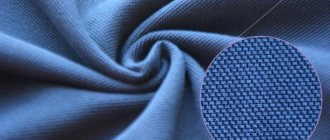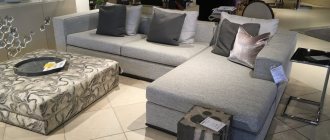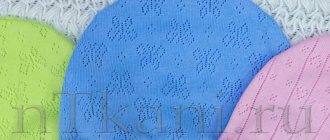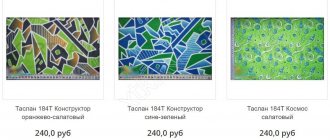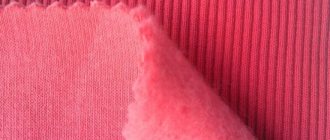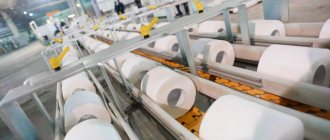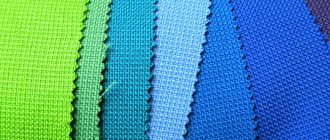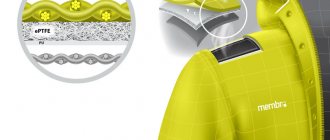History of origin
Appearing back in the 14th century, poplin was originally a slightly rough but pleasant-to-touch mixed fabric based on silk and wool fibers. The special softness and density made the fabric an element of the attire of the upper classes.
The unusual name of this fabric has a whole history - in medieval Avignon, where the technology for producing this functional and spectacular material originates, the residence of the Pope was located. Vestments for clergy were also sewn there, for which poplin was well suited due to its shape stability and attractive appearance. The fabric we know as “poplin” (from the French popeline or Italian papalino) was simply called “papal”.
- Poplin appeared in Russia much later - only at the beginning of the 18th century under the name “European calico”. At first it was imported exclusively from European countries, but later the manufacturing technology was mastered by Russian weavers. In Soviet times, poplin began to be produced en masse in our country.
Recommendations for selection
Poplin bed linen does not go unnoticed and is in great demand. When purchasing such underwear, it is important to make the right choice. To do this, you need to carefully read the information on the packaging.
Poplin set
When choosing poplin bed linen, you need to pay attention to the appearance of the fabric, which should be evenly colored and shiny. The density must be chosen at least 115 threads per 1 cm². The pattern present on the canvas must be clear, and the dimensions must correspond to those specified by the manufacturer.
The poplin material should not smell like paint. Allow only a light aroma of good textiles. You can verify the quality and eliminate the possibility of shedding of the fabric by rubbing it with your hand. If it remains clean, then there is no need to doubt the quality of the product.
What poplin looks like and its weave types
Thin but dense (100-110 g/m2), holding its shape well, suitable for both simple and sophisticated silhouettes, poplin is easy to recognize at first sight. The main feature of the material is the type of weave that forms a small characteristic scar on the surface of the fabric. Up close, you can even see exactly how the threads are connected into the fabric.
The technology for making poplin involves machine-made plain (poplin) weaving of thin warp fibers with thick weft threads, 2 times thicker than for the warp, and the fibers are pressed as closely as possible to each other. The result is a strong and wear-resistant fabric with a soft “reps” surface (dense fibers are “wrapped” in many soft threads).
Varieties of poplin by composition
The most commonly used material in clothing production today is 100% cotton poplin , woven from threads of two different thicknesses. This material is used both for individual tailoring and on a large production scale. An example of quality cotton poplin is Grodesin, which is made from premium quality raw materials in India. Pakistani and Turkish cotton are also excellent for making poplin.
Traditionally, poplin was made from silk fibers; today this technology is used only locally, not on a large scale, due to the high cost of silk raw materials. At the same time, modern technological options are appearing that are not inferior in many characteristics to material with a centuries-old history. Today's analogue of classic silk poplin for tailoring is poplex, a fabric in which a thin and dense cotton base is combined with rare thick synthetic weft threads. Poplex may vary in density and other characteristics, but its cotton content cannot be less than 40%.
To make bed linen in the middle price segment (for the luxury class, only 100% natural ones are chosen, they are denser and softer), another variety of this functional fabric is used - macopoplin or polycotton (polysatin). What kind of material is this? A blend of e-cotton and polyester that, thanks to its synthetic fiber content, holds bright colors well. Also popular are sets of adult and children's bedding made from polypoplin, another mixed variation of the material; according to reviews, products made from it are pleasing with their practicality.
Stretch poplin is a clothing material made of cotton with the addition of lycra. This fabric stretches a little, does not prick, and products made from it fit perfectly to your figure.
There are also types of poplin such as header, extra, elegans.
Varieties of poplin by dyeing method
The color range of modern fabrics, grouped under the “poplin” category, is very diverse. These include plain, printed, and multi-colored fabrics. The following types of poplin differ in the method of dyeing:
- Bleached fabric . A significant part of fabrics with a natural composition undergo the bleaching process - initially such fibers have a natural yellowish, gray tint. Numerous chemicals are used, which are subsequently washed out of the fibers with an alkali solution. As a result, the fabric acquires not only an amazing white shade, but also additional hygroscopicity and a light matte shine.
- With a printed (printed) pattern . Using special printing devices, the design is applied to the fabric using digital printing or airbrushing. Printed fabrics hold small and bright elements of the design well and are safe even for the little ones. Things from them turn out noticeable and unusual.
- Plain-dyed poplin is one of the most common. In this case, an already bleached fabric is dyed; during the process, the fabric is dyed and washed several times, ensuring that the dye is resistant to fading.
- Multicolored material . Such fabric, with a striped or checkered pattern, is obtained if it is woven from already dyed threads.
Poplin bed linen: pros and cons for comfort lovers
Poplin is known to everyone who prefers to sleep on high-quality and comfortable pastel linen. Sleeping on such sheets is as comfortable and healthy as possible.
Poplin bed linen has the following advantages:
- affordable price;
- hypoallergenic;
- environmental friendliness;
- hygroscopicity;
- breathability;
- antibacterial properties;
- strength;
- indestructibility;
- resistance to stretching of threads;
- low maintenance requirements;
- long service life.
All these advantages are characteristic only of high quality material. If poplin is cheap, it can cause an allergic reaction, lose its shape when washed and will not last for a long time.
You might be interested in everything about durable cotton fabric of brown-yellow color (nanki)
Note! If cheap paints were used in the production of the material, then the fabric can not only cause allergies, but also be toxic.
Pros and cons of poplin
Despite the fact that poplin today has many composition options, the most popular option is still a soft and shape-resistant medium-density cotton material. What differences does it have from other types of cotton, what are its advantages and disadvantages?
Let's start with the positives.
- The softness and comfort of poplin are qualities that make it chosen for sewing summer, body-friendly clothing and bed linen.
- Thanks to its natural composition, the fabric has excellent breathability and hygroscopicity, which means it is characterized by proper thermoregulation.
- Despite its high strength and significant wear resistance, the fabric has a medium density and is suitable for underwear.
- Poplin is a material suitable for those with delicate skin and those who are especially sensitive to the composition of the fabric. In particular, it is well suited for both allergy sufferers and people with atopic skin in remission.
- The fabric, due to the fact that it consists of high-quality cotton, is easy to care for and unpretentious to use. Does not fade, does not shrink, and after ironing it retains its perfect appearance until the next wash.
- Thanks to the use of plain weave technology and different fiber diameters, poplin is textured and wrinkle-resistant.
Poplin has very few disadvantages, and if you encounter them, this will be a sign of choosing a low-quality product. The difference in comparison with a worthy example will be obvious. Poplin woven in violation of technology or from poor raw materials quickly becomes frayed, shrinks, puffs form on it, and it may even lose color. If low-quality dyes are used, there may even be a noticeable chemical smell from the fabric.
All this can be avoided if you buy poplin in trusted places - from manufacturers who have repeatedly proven their approach to work, with quality checks for each batch. Poplin may have different names on its label; the most common are cotton and poplin.
Bed linen – poplin, satin, calico – which is better to choose?
The best material for bedding is cotton. The most popular sleep sets are sets made of calico, satin and poplin. To make a choice, you need to carefully study all the pros and cons and conduct a comparative analysis of fabrics.
| Characteristics | Calico | Satin | Poplin |
| Appearance | smooth matte | silky | thin with a matte sheen, fine scars on the surface |
| Tactile sensations | new underwear is a bit harsh, but after a few washes it becomes softer | the most pleasant | smooth, soft, elastic |
| Density | lowest | the tallest | denser than calico and lighter than satin |
| Durability | strong and durable | most durable | slightly inferior to calico |
| Price | lowest | the tallest | average |
| Colors | ordinary | diversity | inferior to satin |
| Ironing | at high temperatures | easy to iron | does not need, does not wrinkle |
| Washing temperature | normal wash at 30-600 | withstands up to 950 | gentle wash at 30-400 |
| Washing cycles | up to 200 | up to 300 | up to 150 |
Having studied all the advantages and disadvantages of fabrics, you can choose the best bedding set for yourself. If luxury, quality are important to you and the price is not scary, then definitely choose satin underwear.
Poplin is a more budget option, but is almost as good in quality. Calico is an even more budget option, simpler, but quite worthy.
What is made from poplin
Many years have passed since the synthetic revolution swept across the world, and gradually the excitement around artificial fabrics is calming down. Everyone understood that in clothing, as in everything else, a balanced approach and reasonable choice are important. For some purposes, practical and affordable synthetic-based materials are better suited; for other purposes, eco-friendly fabrics are better suited. Poplin has returned to fashion - some models using it have become noticeable trends, others fit well into capsules for a basic wardrobe. What are they sewing from different versions of this fabric today?
Despite the fact that poplin cannot be unambiguously called a dress fabric, current dresses - fluffy, tiered, with puffed sleeves - made from poplin are very impressive. Considering that this fabric is hygienic, in the summer it is difficult to find a more convenient option for walking around the city, photo shoots or gatherings in a cafe. Skirts and jackets, tops with complex designs - cotton material copes with a variety of tasks perfectly.
This fabric will also enrich a man's summer wardrobe - stylish shirts or relaxed holiday shorts are indispensable in the warm season. Thin poplin is considered the ideal shirting material, strong, smooth and suitable for layering, it is stronger than regular cotton.
Poplin will also fit into children's looks - oversized is now popular, and the current silhouettes of girls' dresses are looking more and more voluminous. Plain weave fabric has enough density and lightness to give the desired effect. In addition, stains are easily removed from poplin with regular washing, and children can walk without fear of getting dirty.
Of course, we can’t help but mention bedding, which is made from poplin and is very comfortable, durable, and easy to use. This good fabric is also very popular for home textiles - tablecloths, pillowcases for decorative pillows.
How to sew from poplin?
Working with poplin based on premium cotton is a pleasure! The material does not slip on the table at all during cutting and sewing by hand or on a machine, and is resistant to creases.
- Important ! Before cutting the fabric, decating is necessary.
You can then follow the simple steps to create a new product.
- When cutting and basting parts, connect the layers of fabric with thin pins, this will prevent the fabric from shifting during work.
- We recommend using pencils with water-soluble ink as a marking and marking tool. If you choose chalk, test it on a small piece of material first to avoid any greasy marks.
- Select the appropriate needle and presser foot for your machine. Cotton poplin is quite dense, but sometimes, if selected incorrectly, the needle can leave noticeable holes on the surface of the fabric. Which needle is suitable? We recommend fine, sharp needles that are compatible with your machine.
How to choose
The right choice of bed linen is the key to a good mood and comfortable rest for many years.
- You should only buy from a trusted seller. In a branded store from the manufacturer or from an intermediary in whom you are confident. An on-site consultant will always give qualified advice, introduce you to the store’s assortment, and help you with your choice.
- The presence of polyester in textiles makes it stronger, but reduces the cost of the product. Over time, pellets form on the surface.
- When purchasing, pay attention to the quality of the seams. The seam should be smooth, without protruding threads.
- The color and pattern on high-quality fabric is always crisp and clear. The smell of chemicals indicates the use of low-quality dye.
- Natural textiles do not wrinkle. When crumpled, it quickly takes its original shape, leaving no creases.
Caring for poplin products
Cotton poplin is surprisingly unpretentious. Almost any contaminant can be removed from its surface - in general, the recommended water temperature for washing is 40 degrees, but washing in hotter water, up to 60 degrees, is also allowed. If the stains are still not washed off, light, plain poplin can even be boiled.
Spinning at medium and maximum speed will allow you to get almost dry laundry after washing. If additional drying is required, choose options in a shaded area outdoors or in a well-ventilated area.
The canvas practically does not wrinkle, but if there is a need to refresh the look of poplin clothes, select the “cotton” mode on your iron.
Care instructions
Many people, when buying poplin products, unfortunately do not know what kind of fabric it is and how to care for it. In order for products made from this material to be successfully used for a long time, to remain beautiful and soft, it is important to properly care for them. Care consists of proper washing, ironing, drying and storage.
During the period of use of poplin bed linen, you should adhere to the following tips:
- follow the manufacturer's advice and follow the instructions;
- wash inside out;
- if there are zippers or buttons, fasten them;
- After purchasing, you should refresh the set; a delicate washing cycle is best suited for this.
Note! Subsequently, it is better to wash clothes with soft powder. Do not use bleach. Liquid detergents are ideal for washing. Colored items must be washed separately from white items and only special detergents must be used for each.
If the set is made of colored and printed fabrics, then it is strictly forbidden to soak it. In order for the product to look attractive for a long time, it should be washed only on a gentle cycle and not select a water temperature above 40 °C.
When washing poplin PCB in a washing machine, preference should be given to a gentle spin, and when washing by hand, squeeze the material only slightly, without twisting it too much. It is strictly forbidden to use machine drying or dry clothes in the sun. Products are dried in a straightened, hanging form.
You might be interested in what silk is: what types of fabric exist, their description
Ironing of poplin bed linen should be carried out at a temperature of no more than 150 °C. If the product has appliqué, embroidery or rhinestones, then it is better to iron it only from the wrong side without using steam.
The poplin set, clean and ironed, should be stored in a closed linen closet. This way you can avoid burning it out.
Features of care
How to choose poplin?
The modern fabric market is saturated with offers for every taste. With a variety of options, how can you decide and get those materials that will become an excellent basis for your custom-tailored clothing and home textiles?
You recommend fabrics from trusted foreign manufacturers. Poplin made from long-staple cotton from the leading plantations on the planet from our suppliers - a large selection of fabrics of various densities, with different color options from laconic to trendy. We have both basic items and exclusive ones with current designs.
Detailed descriptions and detailed photos indicating the scale of the print will be useful for buyers. They will help you make a choice in favor of materials that exactly suit your needs. The width and cost per linear meter are also indicated in the product cards. There is a convenient sorting by price, you can choose more expensive and cheaper products. Prompt delivery in a convenient way is a nice bonus for those who love quick sewing projects.
Our fabric catalog


